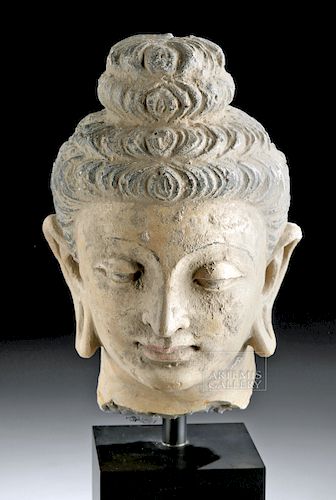Lovely Gandharan Stucco Polychrome Buddha Head
Lot 145
About Seller
Artemis Fine Arts
686 S Taylor Ave, Ste 106
Louisville, CO 80027
United States
Selling antiquities, ancient and ethnographic art online since 1993, Artemis Gallery specializes in Classical Antiquities (Egyptian, Greek, Roman, Near Eastern), Asian, Pre-Columbian, African / Tribal / Oceanographic art. Our extensive inventory includes pottery, stone, metal, wood, glass and textil...Read more
Categories
Estimate:
$6,000 - $9,000
Absentee vs Live bid
Two ways to bid:
- Leave a max absentee bid and the platform will bid on your behalf up to your maximum bid during the live auction.
- Bid live during the auction and your bids will be submitted real-time to the auctioneer.
Bid Increments
| Price | Bid Increment |
|---|---|
| $0 | $25 |
| $300 | $50 |
| $1,000 | $100 |
| $2,000 | $250 |
| $5,000 | $500 |
| $10,000 | $1,000 |
| $20,000 | $2,500 |
| $50,000 | $5,000 |
| $100,000 | $10,000 |
| $200,000 | $20,000 |
About Auction
By Artemis Fine Arts
Jun 20, 2019
Set Reminder
2019-06-20 10:00:00
2019-06-20 10:00:00
America/New_York
Bidsquare
Bidsquare : Ancient / Ethnographic From Around the World
https://www.bidsquare.com/auctions/artemis-gallery/ancient-ethnographic-from-around-the-world-4217
Around the world & back in time - be amazed at the treasures you will find. Antiquities from Egypt, Greece, Italy and the Near East, Asian, Pre-Columbian, African / Tribal / Oceanic, Native American, Spanish Colonial, Russian Icons, Fine Art, much more! All categories, all price ranges.. all legal Artemis Fine Arts info@artemisgallery.com
Around the world & back in time - be amazed at the treasures you will find. Antiquities from Egypt, Greece, Italy and the Near East, Asian, Pre-Columbian, African / Tribal / Oceanic, Native American, Spanish Colonial, Russian Icons, Fine Art, much more! All categories, all price ranges.. all legal Artemis Fine Arts info@artemisgallery.com
- Lot Description
Central Asia, Pakistan, India, and Afghanistan, Gandharan, ca. 2nd to 3rd century CE. An exquisite, life-size stuccoed head of the Buddha, depicted in extremely high relief - nearly in the round, with a wavy coiffure, a generous ushnisha (topknot) as well as a beautiful face that is finely modeled with elegant features including almond-shaped, downcast eyes - the irises/pupils painted a deep blue-grey or black, an elegantly arched browline outlined in black, leading to a slender nose, and full, closed lips painted coral pink. The drama of this visage with its stylized wavy tresses and meditative expression does not discount its naturalism. Notice how skillfully the sculptor rendered the philtrum (vertical groove in midline above the upper lip), the Cupid's bow of the upper lip, the tear troughs between the eyes and nose, the nasal bridge and nostrils, and the contours of the chin. Size: 5.25" L x 5.25" W x 7.75" H (13.3 cm x 13.3 cm x 19.7 cm); 11.5" H (29.2 cm) on included custom stand.
Alexander the Great conquered Gandhara in 330 BCE and with the help of the Indo-Greek kings introduced classical traditions that would influence Gandharan art for the following seven centuries. The stylized curly Mediterranean hair and top knot derive from classical sculptures such as the Apollo Belvedere (330 BCE), and the sensitive modeling of the expressive visage demonstrates a classical influence as well. The stucco technique of this piece shows stylistic affinities with the early stucco production from Ghandaran sites, particularly Taxila. A rare example of Greco-Buddhist art that demonstrates a strong syncretism between eastern and western traditions.
The head of the Buddha is perhaps the most significant element of the deity as it represents the immense body of knowledge and wisdom of Buddha along with the tranquil nature that emanates from his expression. What's more, in this example the sculptor's adept modeling technique allows for a moving spiritual interpretation as opposed to other comparatively colder, stiffer renderings. A peaceful countenance with a rounded ushnisha symbolizing the wisdom and knowledge acquired after attaining enlightenment, and elongated ears, a physical feature symbolic of the Buddha's time as a prince when he wore elaborate ear ornaments to demonstrate wealth and prosperity. Of course, the prince stopped wearing them when he left the palace to become an ascetic; however, his earlobes remained stretched signifying a conscious decision to reject the material world in exchange for spiritual enlightenment and simultaneously suggest that the Buddha can hear all that is asked for and needed in the earthly world. Those half-closed eyes indicate a meditative state - at once looking both outward and inward. Furthermore, the curled hair of the Buddha signifies the nobility of Buddha. Beyond the multi-layered meaning embodied in the iconography of this piece, the sculptor's artistry and technique is exceptional.
Provenance: private East Coast, USA collection; ex-Joe Gerena Fine Arts, New York, USA, acquired in the 1990s
All items legal to buy/sell under U.S. Statute covering cultural patrimony Code 2600, CHAPTER 14, and are guaranteed to be as described or your money back.
A Certificate of Authenticity will accompany all winning bids.
We ship worldwide and handle all shipping in-house for your convenience.
#147186Losses to back of head and neck as shown. Tip of left ear reattached. Chips to edges of ears. Surface wear with some pigment loss but nice painted details have survived. Normal scuffs and nicks here and there as shown. Earthen deposits grace the surface.Condition
- Shipping Info
-
All shipping is handled in-house for your convenience. Your invoice from Artemis Gallery will include shipping calculation instructions. If in doubt, please inquire BEFORE bidding for estimated shipping costs for individual items.
-
- Buyer's Premium



 EUR
EUR CAD
CAD AUD
AUD GBP
GBP MXN
MXN HKD
HKD CNY
CNY MYR
MYR SEK
SEK SGD
SGD CHF
CHF THB
THB














